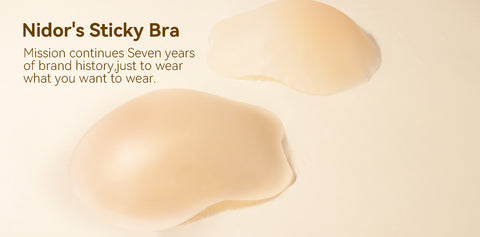
Introduction
In recent years, a concerning rumor has circulated that sticky bras may be linked to an increased risk of breast cancer. This claim has caused alarm and confusion among many women who rely on adhesive bras for support and fashion purposes. As a result, it's crucial to separate fact from fiction and address the question: Can sticky bras cause cancer?
In this comprehensive article, we will delve into the topic, examining the available scientific evidence, expert opinions, and personal experiences. By the end, you'll have a clear understanding of the relationship, if any, between sticky bras and breast cancer. Let's get started.
Understanding the Concerns
The concerns surrounding sticky bras and their potential connection to breast cancer stem from the misconception that the adhesive used in these bras contains harmful chemicals or toxins that could trigger cancerous growths. It's important to note that adhesive bras are typically made from medical-grade materials, including hypoallergenic adhesives that are deemed safe for use on the skin.
 Debunking the Myth: Lack of Scientific Evidence
Debunking the Myth: Lack of Scientific Evidence
To date, there is no scientific evidence to support the claim that sticky bras cause cancer. Numerous studies conducted by reputable institutions, including the American Cancer Society and the National Cancer Institute, have found no conclusive link between adhesive bras and breast cancer.
One study published in the Journal of Clinical Oncology examined a large cohort of women and found no association between the use of adhesive bras and breast cancer risk. Additionally, the American Cancer Society states that there is no scientific evidence to support the claim that any type of bra, including sticky bras, increases the risk of breast cancer.
Understanding Breast Cancer Risk Factors
While sticky bras have been debunked as a risk factor for breast cancer, it's essential to be aware of the established risk factors for this disease. Understanding these risk factors can help women make informed decisions about their breast health and take necessary precautions.
Age
Age is a significant risk factor for breast cancer. The risk increases as women grow older, with the majority of breast cancer cases occurring in women over 50. However, it's important to note that breast cancer can affect women of all ages, including younger women.
Family History and Genetics
A family history of breast cancer can elevate an individual's risk of developing the disease. In particular, having a first-degree relative (such as a mother or sister) who has had breast cancer can increase the likelihood of developing breast cancer. Additionally, certain genetic mutations, such as BRCA1 and BRCA2, are associated with a higher risk of breast cancer.
Hormonal Factors
Hormonal factors can influence breast cancer risk. Women who started menstruating at an early age or experienced late menopause have a slightly higher risk. Additionally, the use of hormonal contraceptives and hormone replacement therapy (HRT) may affect breast cancer risk, albeit to a small extent.
Lifestyle Factors
Certain lifestyle choices can impact breast cancer risk. These include:
- Alcohol Consumption: Regular and excessive alcohol consumption has been linked to an increased risk of breast cancer. It is advisable to limit alcohol intake to reduce the risk.
- Physical Activity: Engaging in regular physical activity can help reduce the risk of breast cancer. Aim for at least 150 minutes of moderate-intensity exercise or 75 minutes of vigorous-intensity exercise per week.
- Diet: A balanced diet rich in fruits, vegetables, whole grains, and lean proteins is associated with a lower risk of breast cancer.
Early Detection and Breast Self-Exams
Regardless of bra type, early detection plays a crucial role in improving breast cancer outcomes. Regular breast self-exams and mammograms are essential for detecting any changes in the breast tissue.
Breast Self-Exams
Performing monthly breast self-exams can help women become familiar with their breasts and detect any abnormalities. Here's a step-by-step guide to conducting a breast self-exam:
-
Visual Examination: Stand in front of a mirror and visually inspect your breasts, looking for any changes in size, shape, or skin texture. Note any visible lumps, dimpling, or changes in nipple appearance.
-
Manual Examination: Lie down and use the pads of your fingers to gently feel your breasts in a circular motion, checking for any lumps, thickening, or unusual changes. Pay attention to the entire breast area, including the armpit and collarbone regions.
-
Nipple Examination: Gently squeeze each nipple and check for any discharge or pain.
If you notice any persistent changes or abnormalities during a self-exam, it's crucial to consult a healthcare professional for further evaluation.
Mammograms
Mammograms are specialized X-ray examinations that can detect breast cancer in its early stages, often before any noticeable symptoms are present. These screenings are typically recommended for women aged 40 and above, although individual risk factors and medical history may influence the timing and frequency of mammograms.
It's important to consult with a healthcare provider to determine the most appropriate screening schedule based on your unique circumstances.
YOU ABSOLUTELY CAN CHOOSE NIIDOR STICKY BRA
Conclusion
In conclusion, the myth that sticky bras cause cancer is unfounded. Scientific research and expert opinions have consistently debunked this claim, assuring women that adhesive bras are safe to use. It's important to focus on established breast cancer risk factors and engage in regular breast self-exams and mammograms for early detection.
Remember, while sticky bras can enhance your comfort and style, they do not pose a risk to your breast health. Stay informed, prioritize self-care, and consult healthcare professionals for personalized guidance. Your breast health matters, and proactive measures can help detect and treat breast cancer effectively.
Additional Resources:
Disclaimer: This article is for informational purposes only and should not be considered medical advice. Please consult with a healthcare professional for personalized guidance and recommendations.
Related Contents:
WHY DO YOU NEED AN ADHESIVE BRA?
HOW TO MEASURE FOR A BRA THAT FITS?
The Ultimate Guide to Sticky Bras: How They Work and Which One is Right for You





